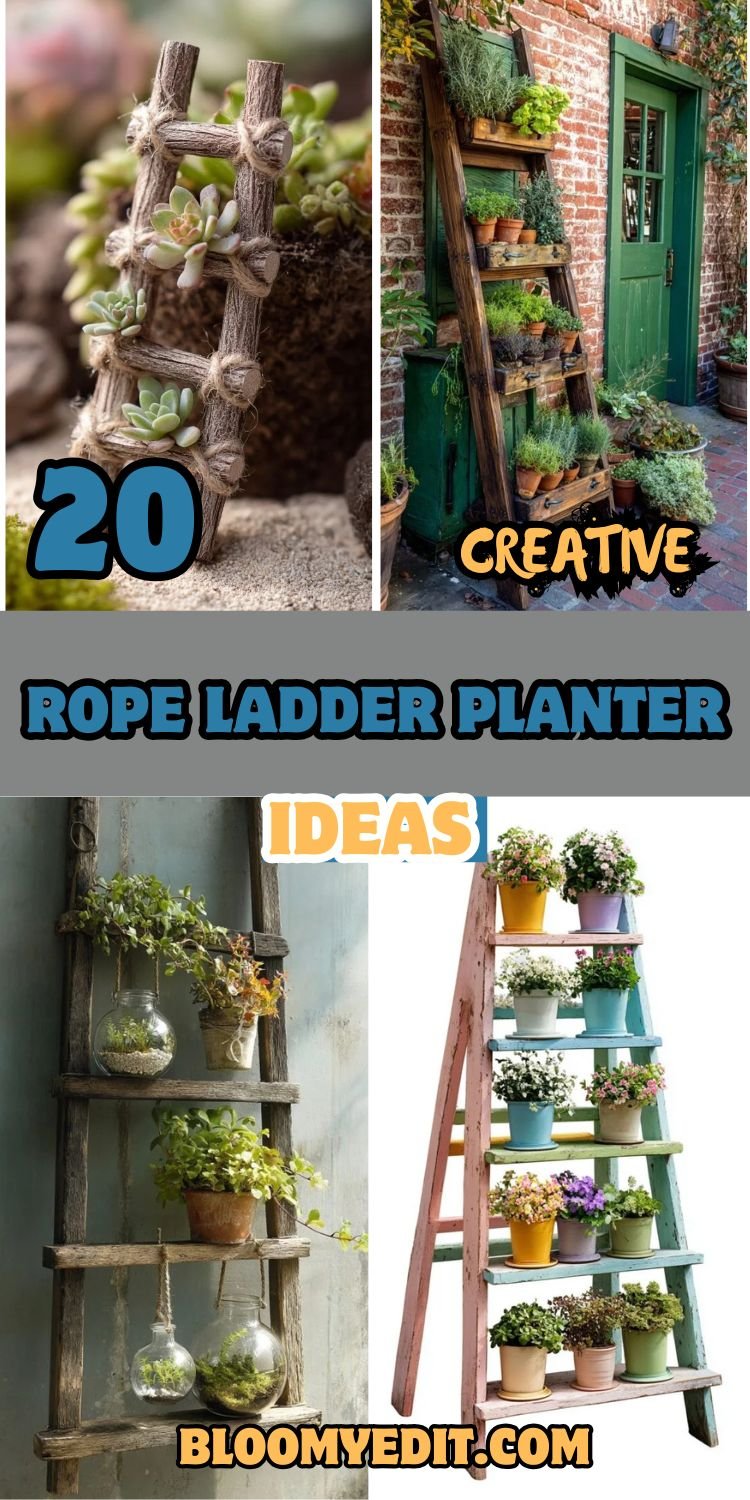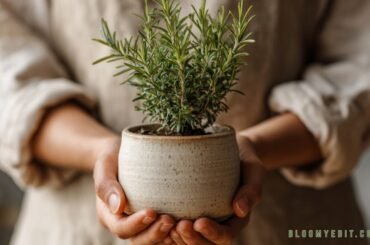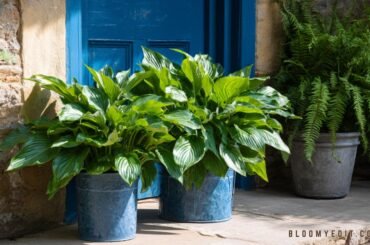You’ve got that one blank wall or awkward corner, too small for furniture, too bare to ignore, and you want something green, vertical, and a little bit different.
That’s where a rope ladder planter comes in. Part garden, part wall art, all charm. And the best part? You can make one yourself with just a few supplies and a free afternoon.
This isn’t a complicated woodworking project or a trip to the hardware store for things you’ll never use again. It’s simple, flexible, and totally customizable.
Whether you’re into boho vibes with terracotta pots and jute rope, or something sleek and modern with painted wood and clean lines, this DIY can swing either way, literally.
Here’s what you’ll need:
- Wood slats or sturdy dowels (for the rungs)
- Rope (jute, nylon, or cotton—whatever fits your style)
- Planters or small pots (lightweight is key)
- Hooks or a rod for hanging
- Drill and measuring tape for assembly
- Optional: paint or stain to finish the wood
Basic Steps:
- Measure & Cut: Decide how many rungs you want and how tall your ladder should be. Cut your wood to size.
- Drill Holes: At each end of the slats, drill holes for the rope to pass through.
- Thread the Rope: Weave the rope through the holes, knotting below each rung to keep it secure. Make sure it’s balanced and even.
- Add Planters: Attach lightweight pots with S-hooks, macramé holders, or plant clips. Keep weight evenly distributed.
- Hang & Style: Mount it from a hook, ceiling beam, or wall bracket. Add trailing plants, herbs, or succulents and let it grow wild.
This project isn’t just a space-saver, it’s a conversation starter. A vertical garden with movement, texture, and personality. Perfect for small spaces, patios, kitchens, or anywhere that needs a little life.
So grab your rope, pick your plants, and get ready to elevate your green game—one rung at a time.
20 Charming Ladder Planter Setups (That Anyone Can Build)
1. Repurpose a Wooden Ladder for Tiered Garden Display
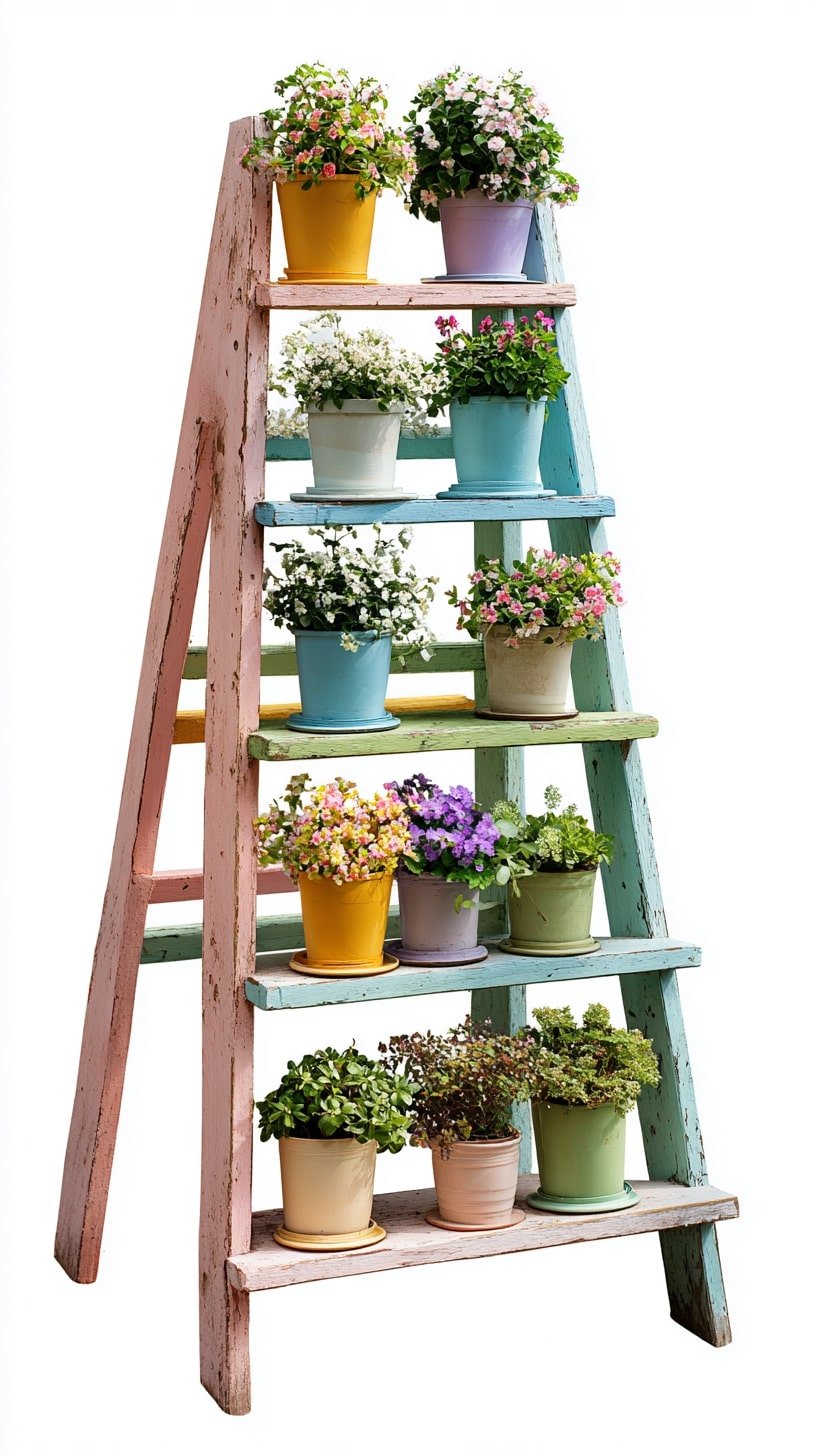
Skip fancy shelving. This weathered A-frame ladder does more with less. The staggered rungs turn into tiered display zones, ideal for trailing blooms, bushy herbs, or seasonal color pops. Each level holds two to three planters, spaced just enough to let leaves breathe.
Soft pastel paint adds charm without clashing. Pale mint, lavender, blush pink ,they nod to farmhouse ease. Notice how pot colors echo the frame? That keeps things visually tight, even when plant textures vary. Bold yellows and sky blues on top grab attention fast.
A clever vertical format for tight porches, narrow patios, or balcony corners. Lightweight, easy to move. Just lean and layer.
2. Suspend Glass Terrariums from a Rustic Ladder Frame
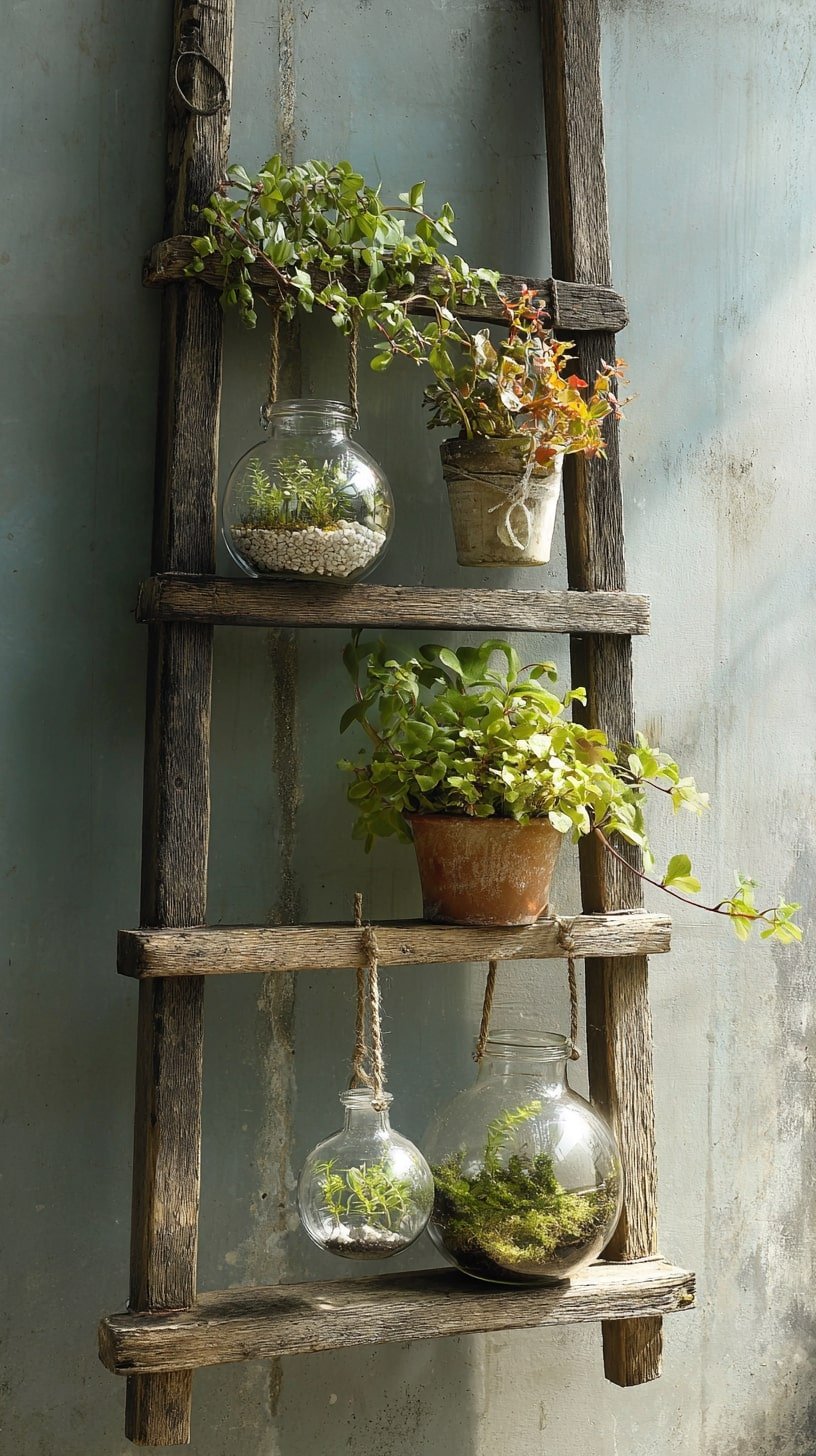
Let structure meet softness. A reclaimed rope ladder, faded and splintered, plays host to airy glass globes and moss-filled terrariums. They dangle from twine like quiet pendants, catching soft light.
Planters perch and hang, layered deliberately. Weighty terra cotta sits solid on rungs. Transparent vessels hover, offering contrast. It’s a slow, almost meditative arrangement , no color overload, just shape, texture, shadow.
An idea rooted in simplicity. No screws, no fuss. Just wood, rope, and patience. Perfect for shaded balconies or interiors craving a green pause.
3. Stack Terra Cotta Herbs on a Ladder for Rustic Charm
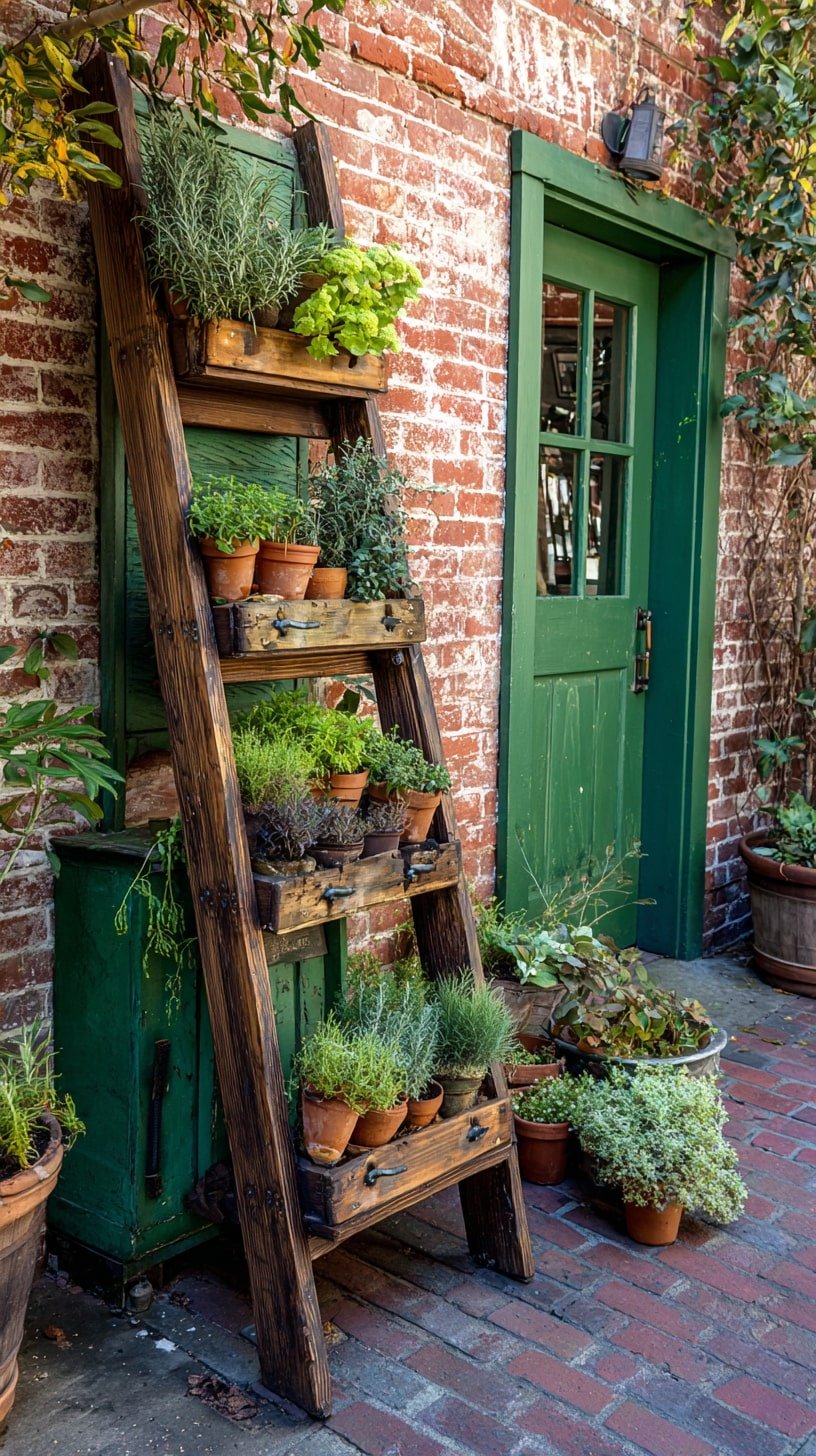
Built to work. This ladder pulls double duty, holding rows of terracotta pots packed with herbs and edibles. Mint, rosemary, thyme , all get their own pocket of sun. Narrow drawers fixed between rungs keep things orderly but full. No clutter. Just function layered with texture.
Charred wood adds depth. Those burnished tones? They echo the red brick and make greens pop harder.
Tucked near a kitchen door, it’s not just pretty. It’s smart. One step outside, and you’ve got flavor at arm’s reach.
4. Scale Down with a Miniature Rope Ladder for Succulent Accents
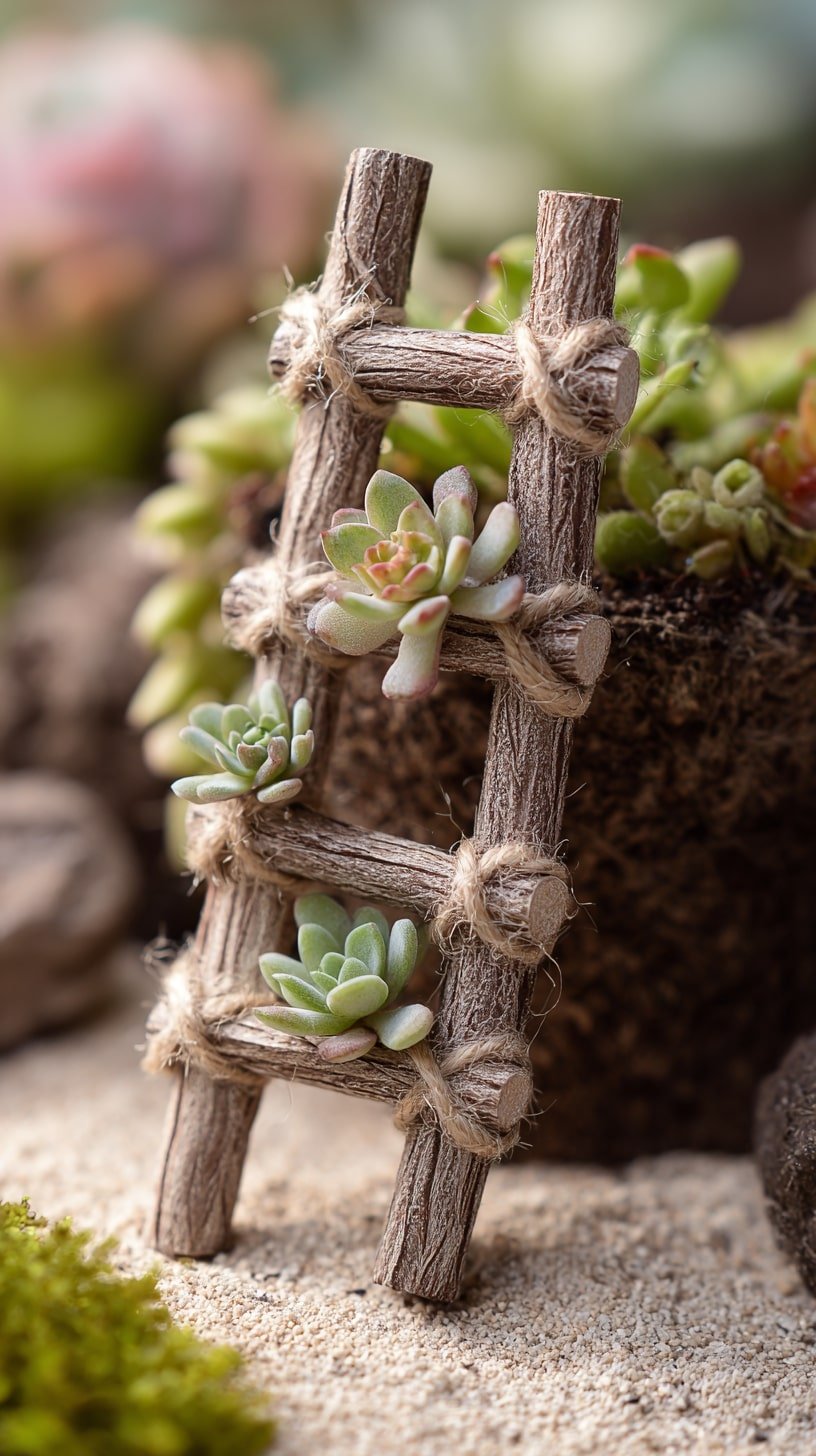
Go small. Really small. This handcrafted twig-and-jute ladder, barely taller than a teacup, turns succulents into sculptural statements.
Each rung cradles rosettes snugly, their plump leaves tucked into the knots of natural rope.
It’s playful but precise. Every detail, the fiber tension, the weathered grain , carries weight. Great for fairy gardens, terrariums, or quirky indoor planters. Adds texture where soil meets story. A tiny structure, huge charm.
5. Anchor Thick Rope to Elevate a Farmhouse Ladder Garden
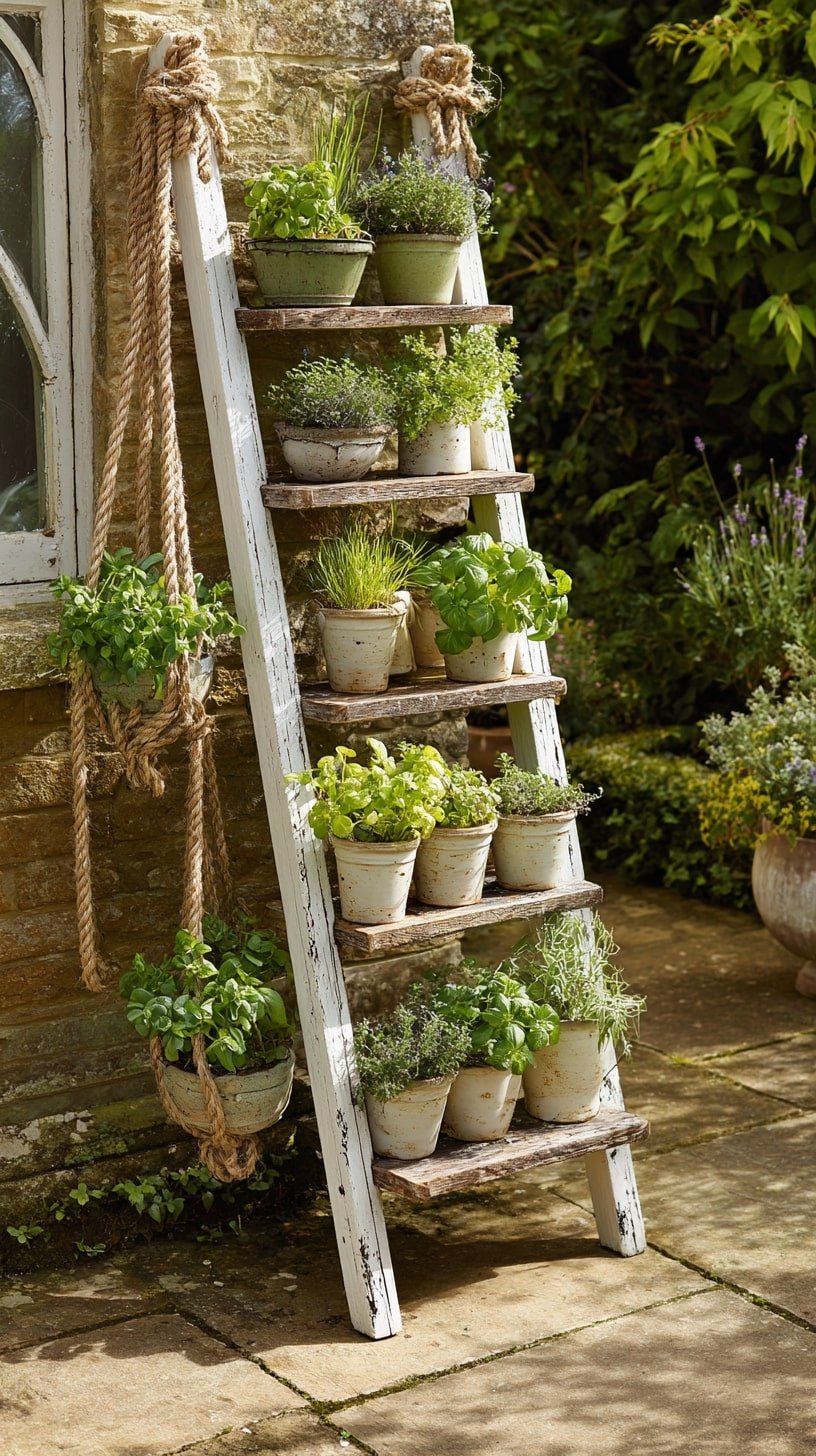
Rope isn’t just detail here. It’s structural. Two oversized jute cords, looped and knotted with muscle, ground this whitewashed ladder into place.
Adds weight, presence. Feels nautical but rustic, almost like dock gear repurposed for the garden.
Spacing’s smart. Each rung holds matching clay pots, evenly spaced but slightly tilted , that tilt helps herbs catch sun at different angles.
Aging paint adds charm, not clutter. Green-on-white pops, clean and fresh. Great for courtyards or cottage walls needing structure without bulk.
6. Suspend Woven Baskets on a Ladder Frame for Balcony Greenery
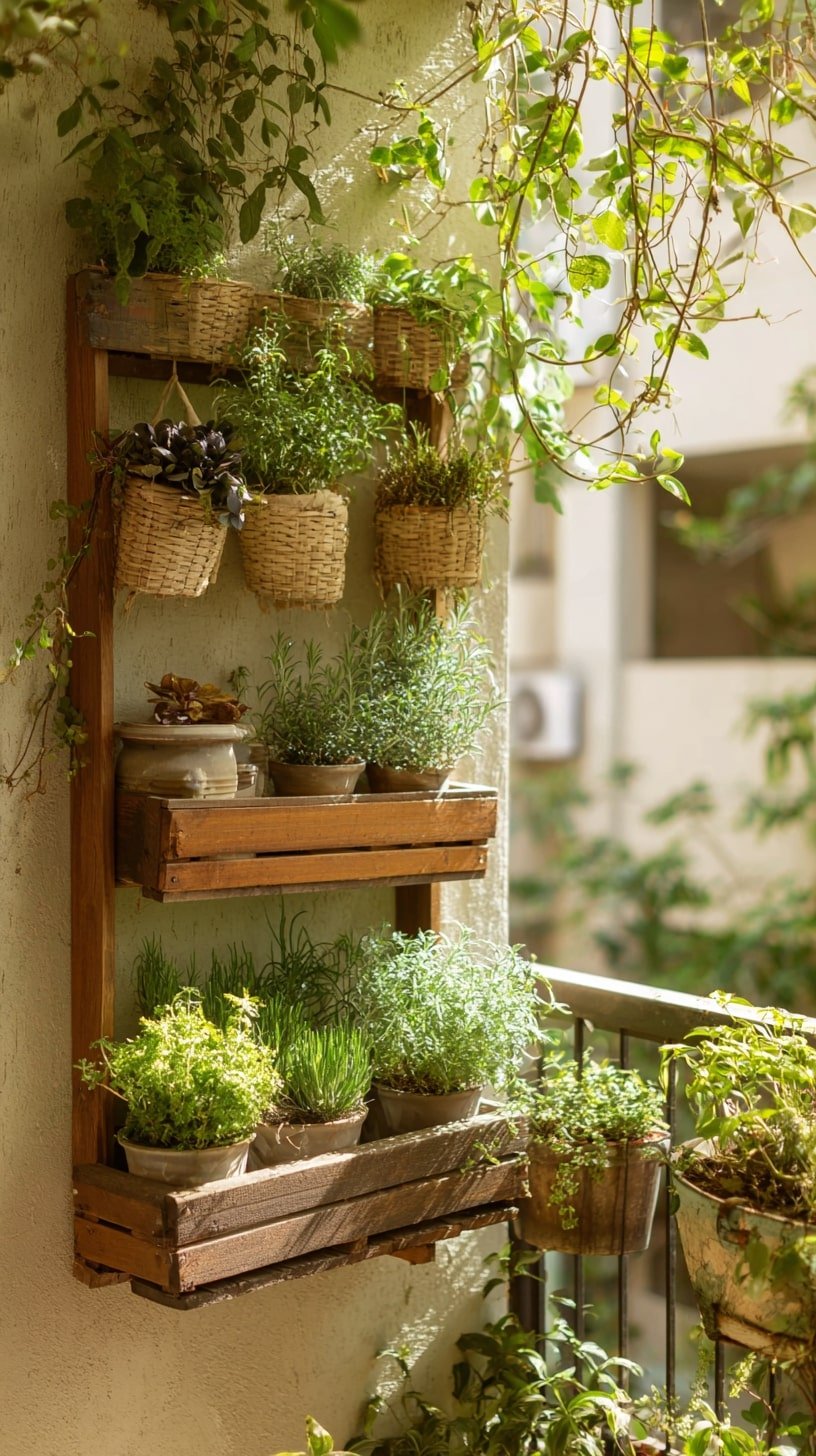
Use height, not floor. Here, a sturdy wooden ladder becomes a vertical garden, with crates and hanging rope baskets layered against a sunny wall. It’s compact, smart, and deeply textured , perfect for balconies or narrow porches.
Materials do the talking. Slatted crates anchor rows of pots, while woven planters dangle mid-air. There’s tension, rhythm. Rough fibers meet soft herbs.
Every piece breathes. Sun hits leaves, shadows shift. Feels lived-in, never staged. A layout that reads slow mornings and fresh cuttings.
7. Combine Mason Jars and Herbs on a Weathered Ladder Frame
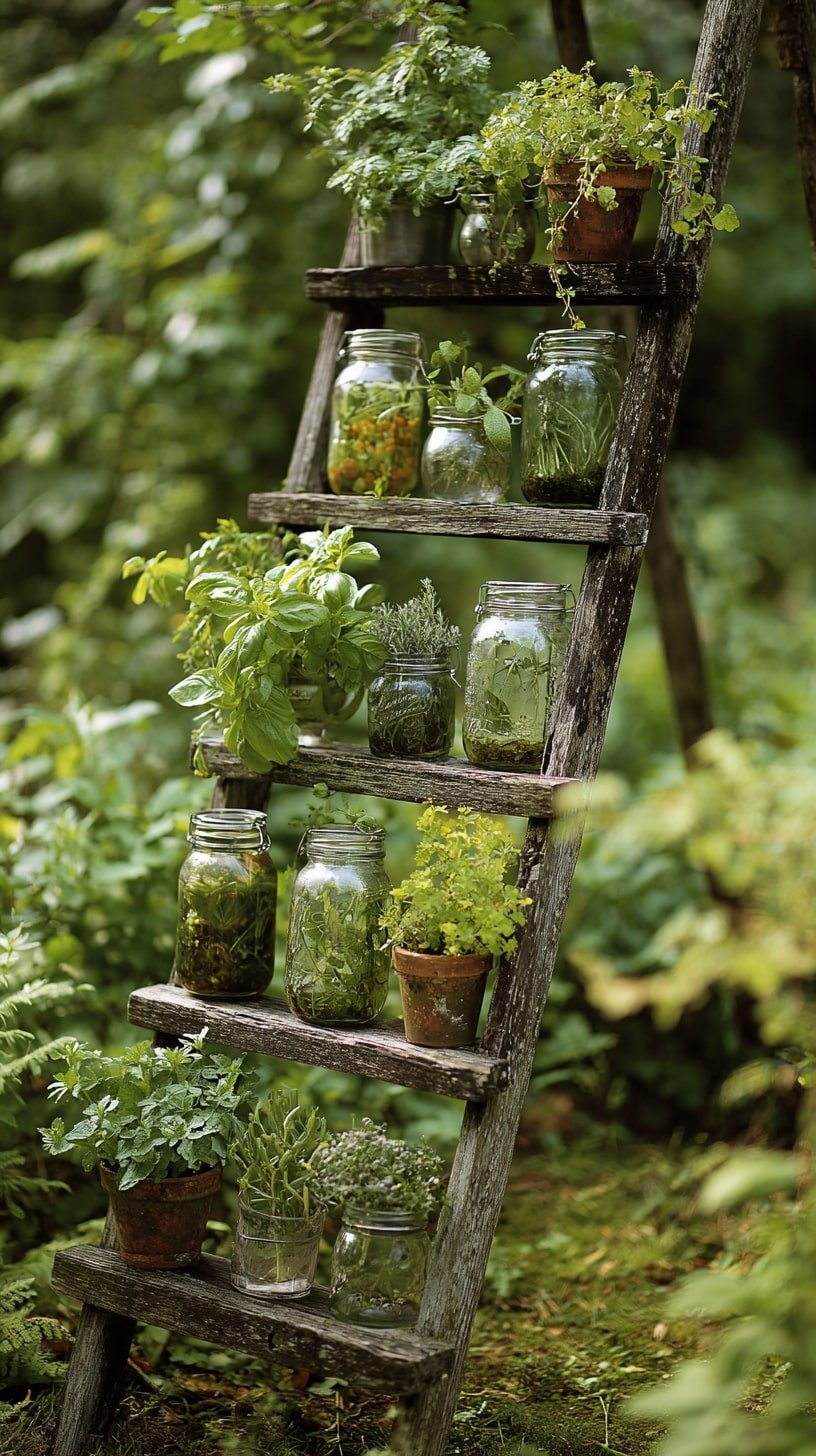
Bring old wood to life. This moss-kissed ladder leans soft into a wild green backdrop, holding glass jars packed with pickled herbs, cuttings, and fresh sprigs. Clay pots break the rhythm.
A few leaves spill over. Nothing staged, everything gathered.
It feels slow. Rooted. Like something from a forest kitchen. Each shelf tells its own story , from fresh basil to dill steeping in brine.
Sunlight filters through green leaves and old glass. A setup made for harvesting, not just looking. Ideal for off-grid gardens, edible corners, or for anyone who prefers wild over styled.
8. Pair Woven Baskets with a Leaning Ladder for an Indoor Earthy Look
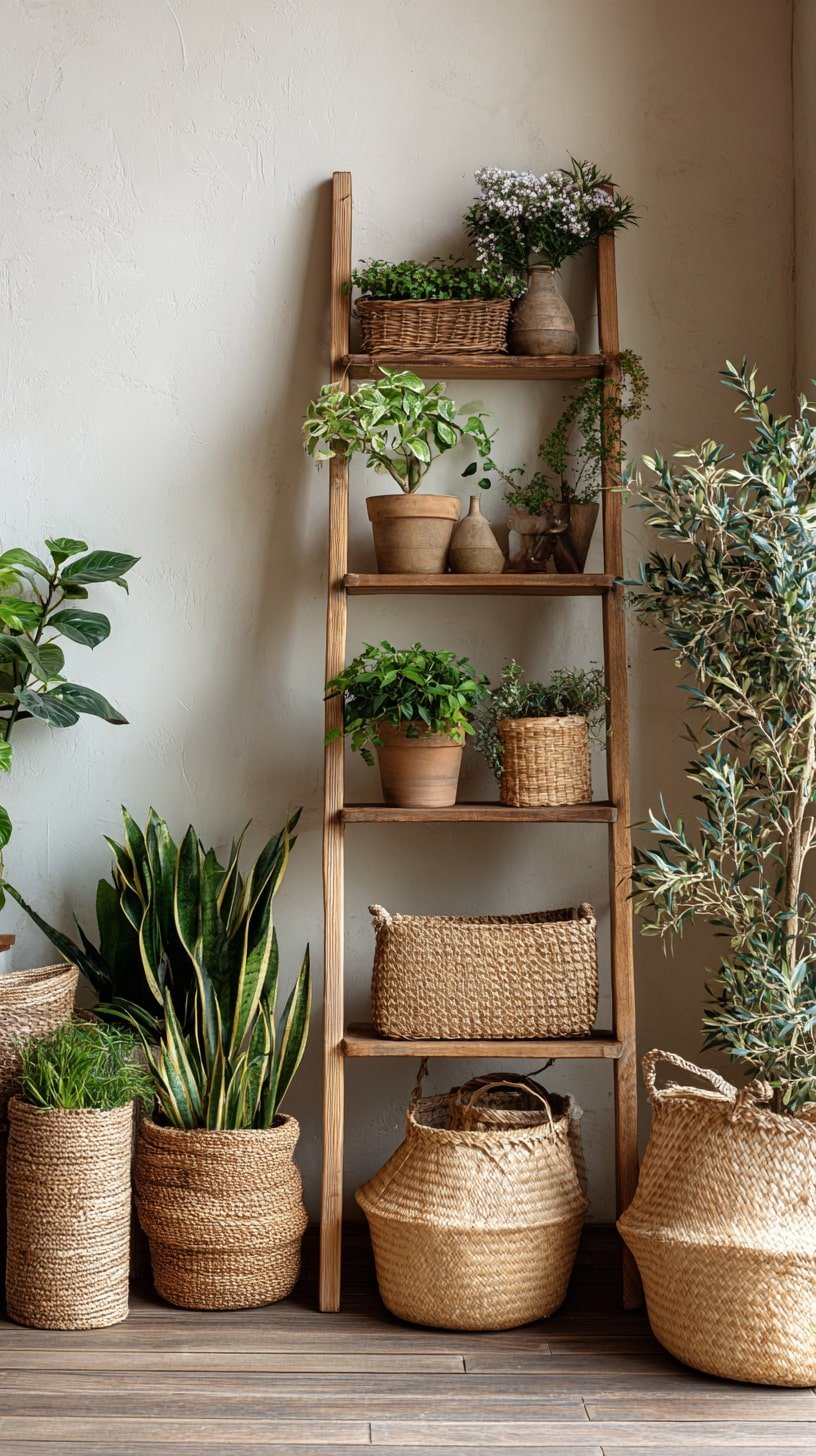
Soft contrast works. Warm-toned wood meets textured fiber. A slender leaning ladder holds terra cotta pots, trailing greens, and tucked-in baskets.
Below, a crowd of belly baskets creates rhythm , tall, short, narrow, wide. No two match, yet they belong.
Plant scale shifts too. Snake plants anchor. Herbs fill gaps. Olive branches peek. Everything feels quiet but full.
A grounded take on vertical gardening, especially for light-filled interiors that need structure without bulk. Feels curated, not crowded.
9. Suspend Sleek Shelves with Rope for a Clean Indoor Vertical Garden
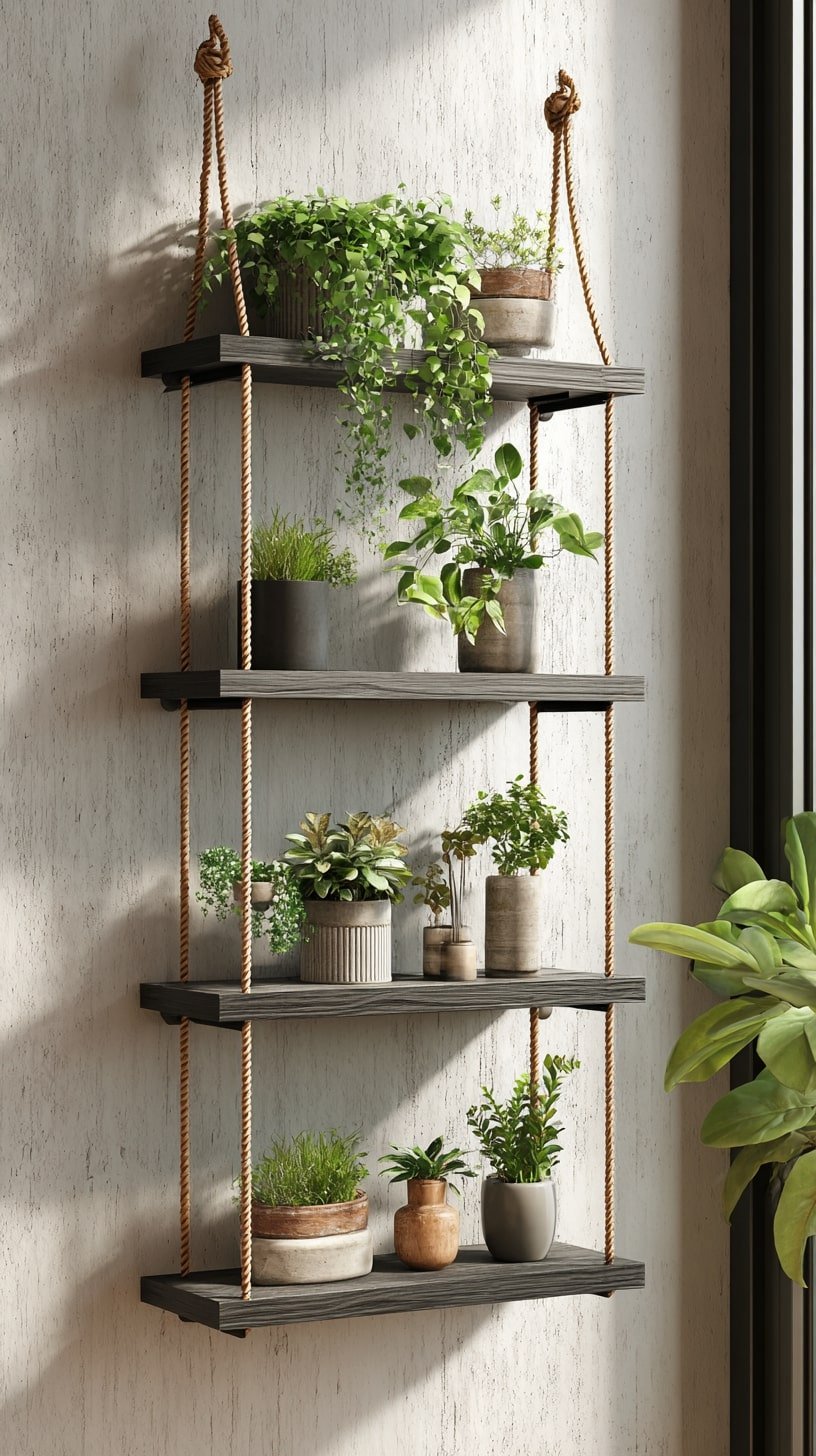
Let the rope carry the weight. Thick natural cord suspends four deep charcoal shelves, bringing balance between rustic texture and modern form. It’s simple, yes, but bold too. Everything hangs neatly, even the light.
The layout reads architectural. Plants shift by height and leaf shape , upright stalks, trailing vines, full crowns. Pot materials stay neutral: concrete, clay, ceramic.
No color chaos. Just greens, shadows, and clean lines. An ideal pick for minimalist interiors craving plant life without clutter. Strong visual order. Soft botanical impact.
10. Wrap Rope Around a Ladder Shelf to Ground Succulent Displays

Go full texture. This compact wooden ladder blends clean structure with rugged softness. Natural jute rope coils up each side , not just decor, but anchor.
Feels nautical, grounded. Makes a bold frame for the soft geometry of succulents.
The rhythm’s tight. Three tiers, grouped by shape and tone. Worn clay pots, woven baskets, trailing greens.
Wood grain matches the floor, drawing everything down. Works perfectly for indoor corners that need a little height, a little life, no fuss.
11. Use Bamboo Rails to Build a Light, Earthy Plant Ladder
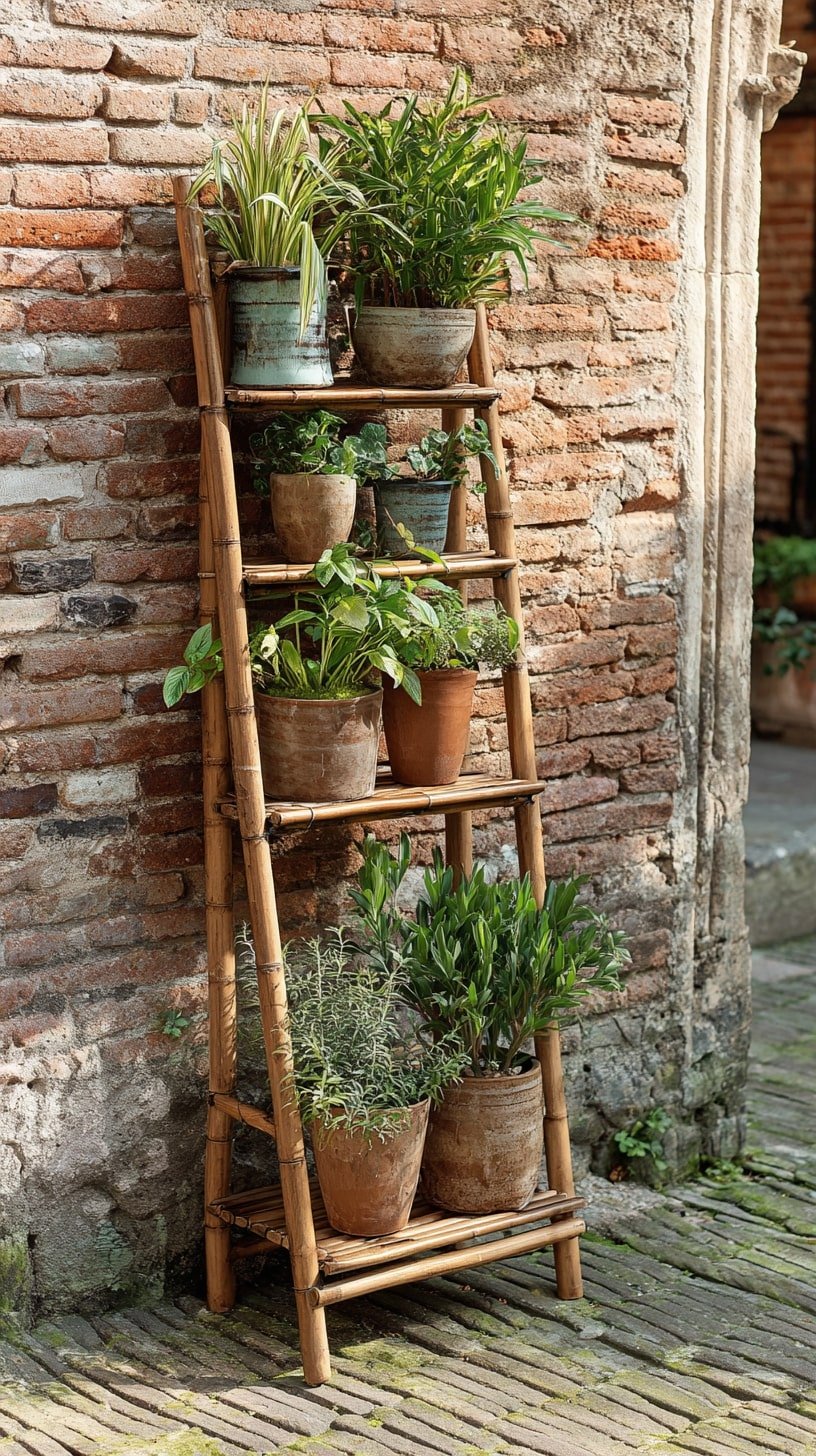
Low weight, high character. This bamboo ladder shelf leans quietly against brick, adding vertical greenery without stealing space.
Slim rails, bound with dark jute, keep the structure loose and breathable , no heavy frame, no visual bulk.
Clay pots do the rest. Weathered tones. Patina here and there. Varied heights bring rhythm, not clutter. Great for breezeways, courtyards, or entry nooks craving life without fuss. Structure is barely there, but presence? Strong.
12. Hang Chunky Wood Crates with Rope for a Rustic Succulent Wall
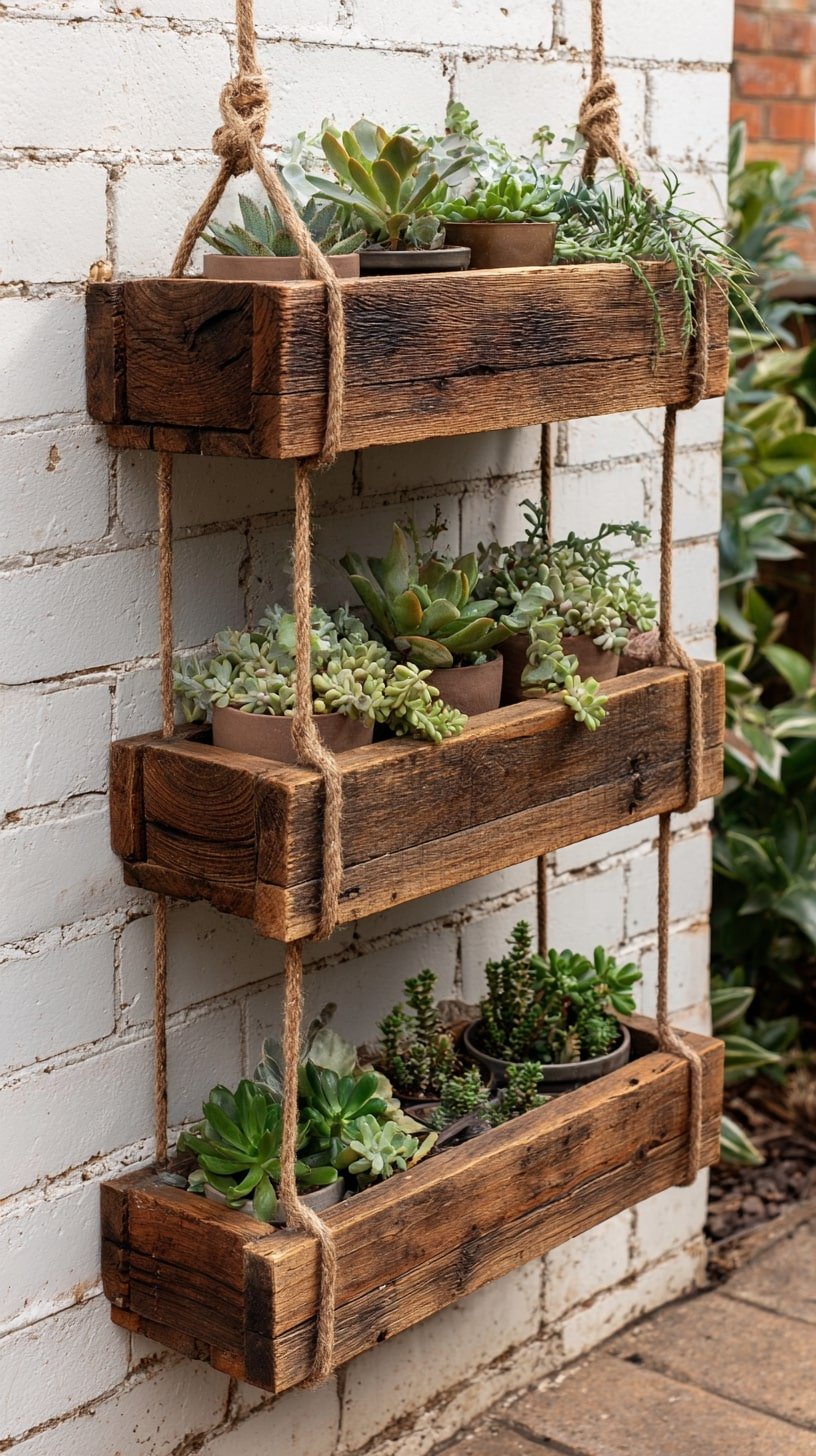
Weight meets texture. Thick reclaimed boards form deep planting boxes, stacked like drawers and strung tight with coarse rope.
Three tiers, no nails, no brackets. Just mass held in suspension.
13. Drape Thick Rope Over a Rustic Ladder for a Succulent Focal Point

Weighty rope. Rough timber. Thick knots loop over the top rail, anchoring a hanging bowl of succulents that almost bursts at the seams. Below, weathered wood shelves cradle more ,rosettes, spillers, jade tones tight-packed like puzzle pieces.
It’s not delicate. It’s sturdy, grounded. Built for sun. Textures clash but complement , hemp, bark, waxy leaves.
Every inch tells you: outdoor space, lived-in. Perfect for desert corners or xeriscaped patios needing vertical rhythm, not fluff.
14. Suspend Ring Planters with Rope for a Sculptural Vertical Accent
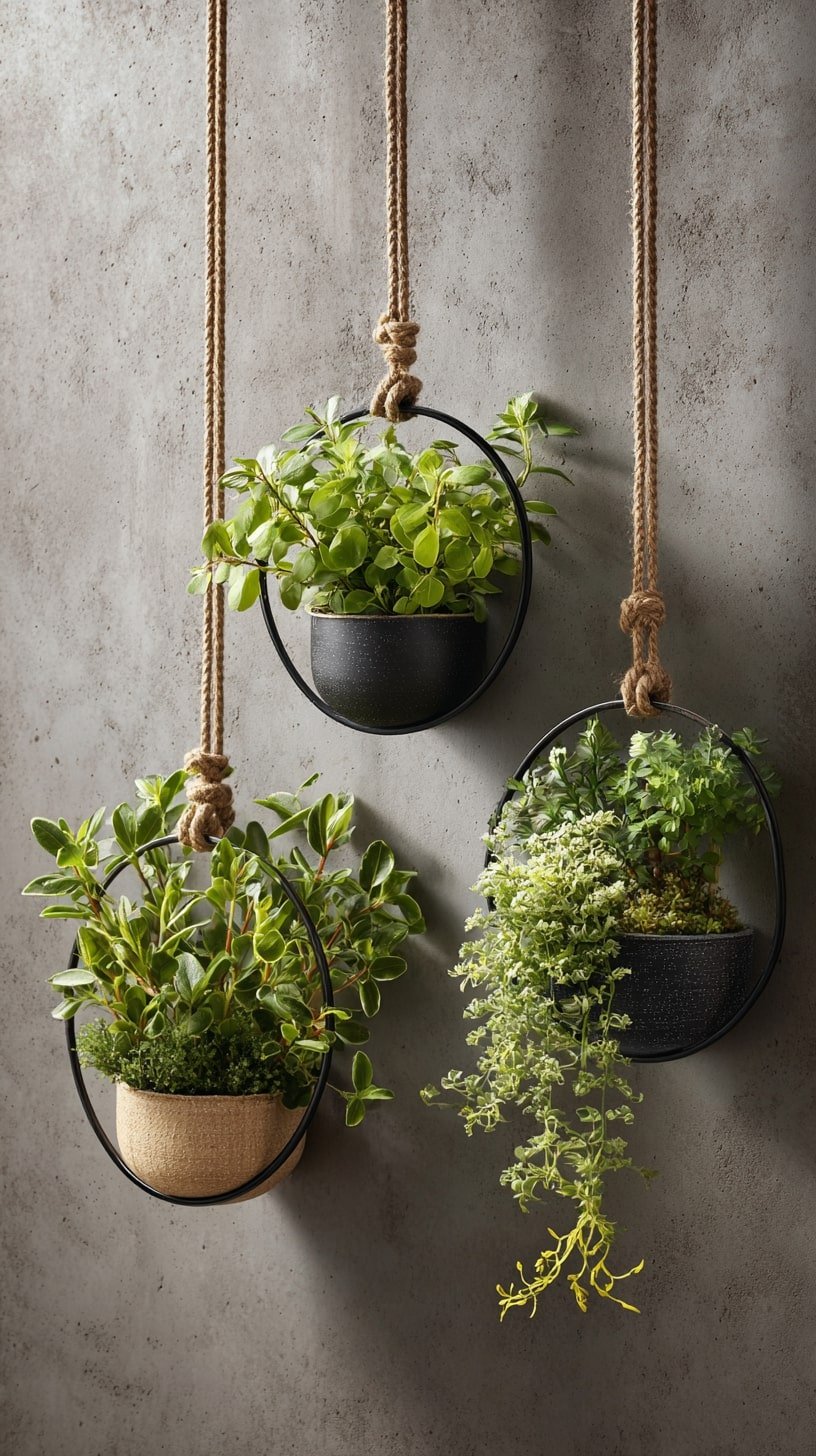
Minimal form, big impact. Each planter hangs from thick rope, framed by a black metal ring that floats against concrete. No shelves. No bulk. Just clean curves and tension lines.
Visual rhythm is key. Three staggered drops, different heights. Plants vary , upright, spilling, rounded. Texture shifts with each ring.
Feels part art, part garden. Works beautifully indoors, especially where wall meets light. Bold, but silent.
15. Knot Rope Around Rustic Shelves for a Tiered Herb Ladder
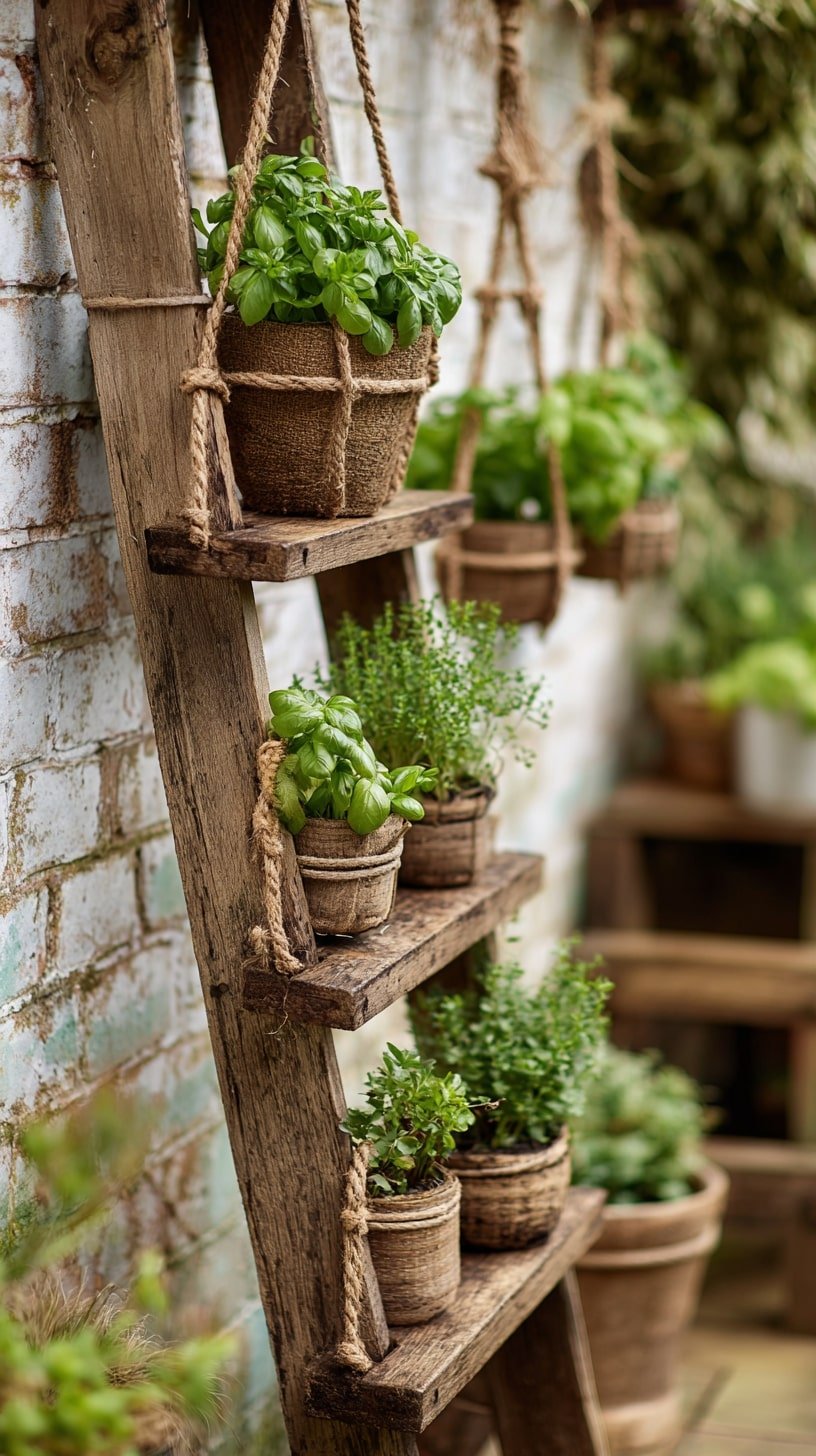
This setup is all grit and purpose. Thick jute rope wraps tightly around rough wood rungs, suspending woven pots full of basil, thyme, mint. It’s not polished , and that’s the point.
Edges show wear. Grain is split. Rope sags just slightly under weight.
The layout flows. Loose but rhythmic. Scent and texture do the rest. Perfect for cottage walls or weathered patios needing structured greenery without losing charm. Rustic feels real here.
16. Pack Succulents Tightly into Tilted Ladder Trays for Bold Color Layers
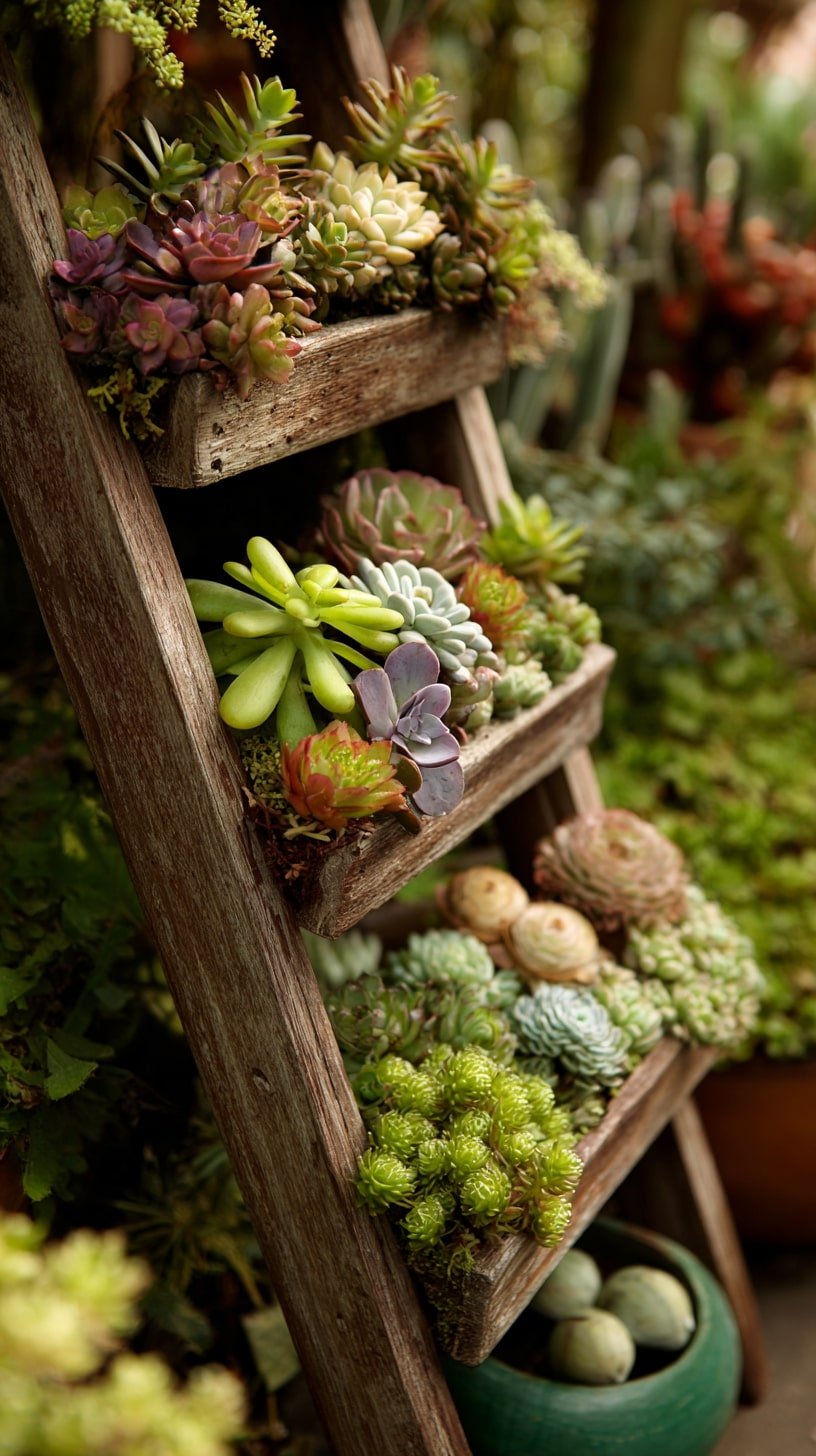
Overflow with form. Each rung is a deep box, tilted just enough to spotlight the dense textures of rosette succulents.
Chartreuse, plum, sage , color shifts subtly. Leaf shapes echo and interrupt. No gaps. No fluff.
The ladder itself? Old. Weather-beaten. Cracked in places. But it holds strong. That contrast, aged wood, fresh growth , carries weight. Best suited for tucked-away garden corners where detail rewards a closer look. Quiet drama, up close.
17. Suspend Mason Jars from Rungs to Spotlight Herbs Midair
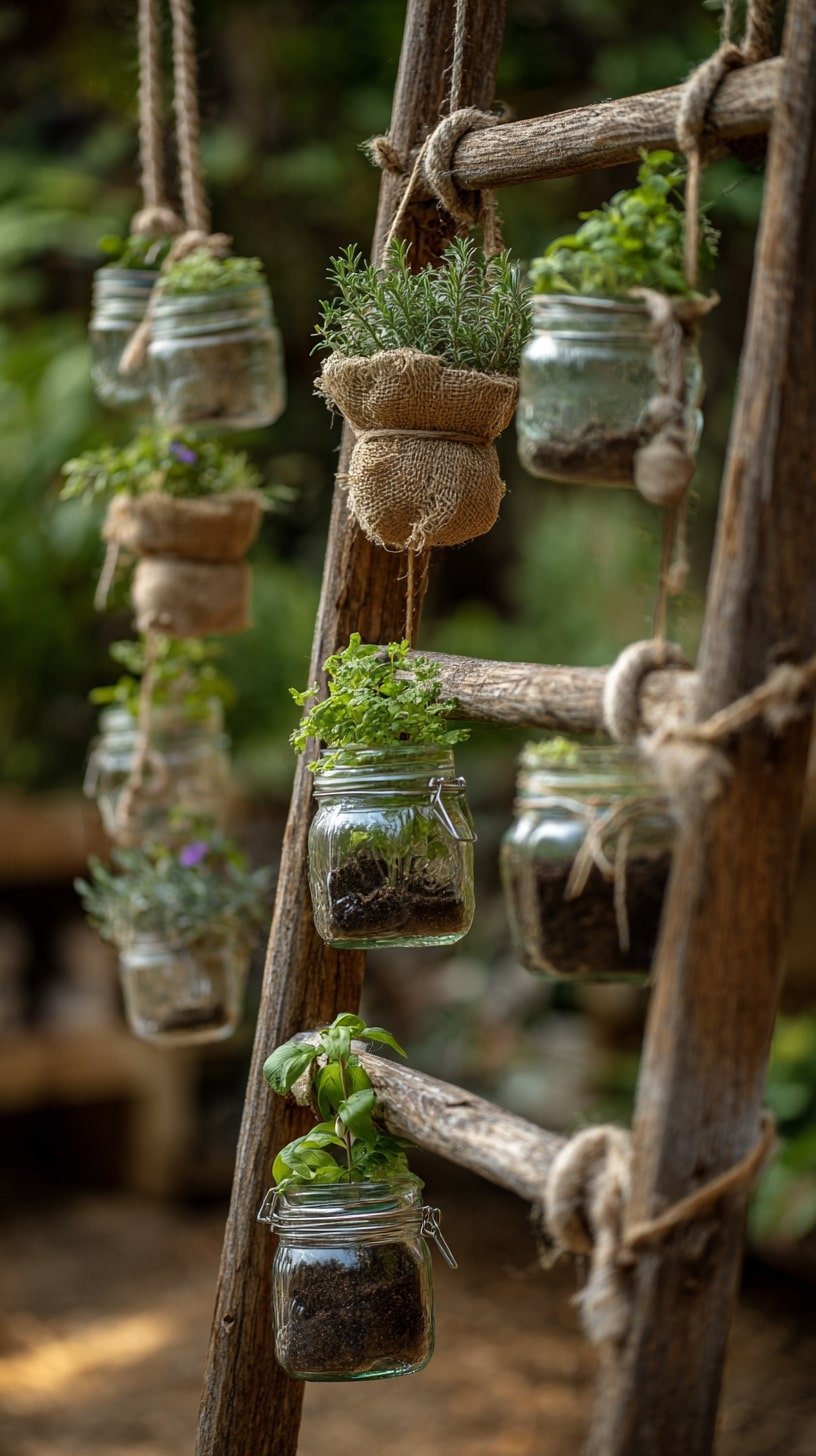
Rethink gravity. Instead of shelves, this setup swings jars along thick rope from each wooden rung. It’s both airy and dense. The glass reveals root texture, soil moisture, micro details you normally miss.
Burlap wraps add grit. Imperfect knots, some jars tilted , that looseness feels alive. Best for herbs. Basil, thyme, mint. Easy to grab, beautiful to grow. Unexpected. Honest. Tactile.
18. Weave Macramé into Shelving for a Soft Boho Statement
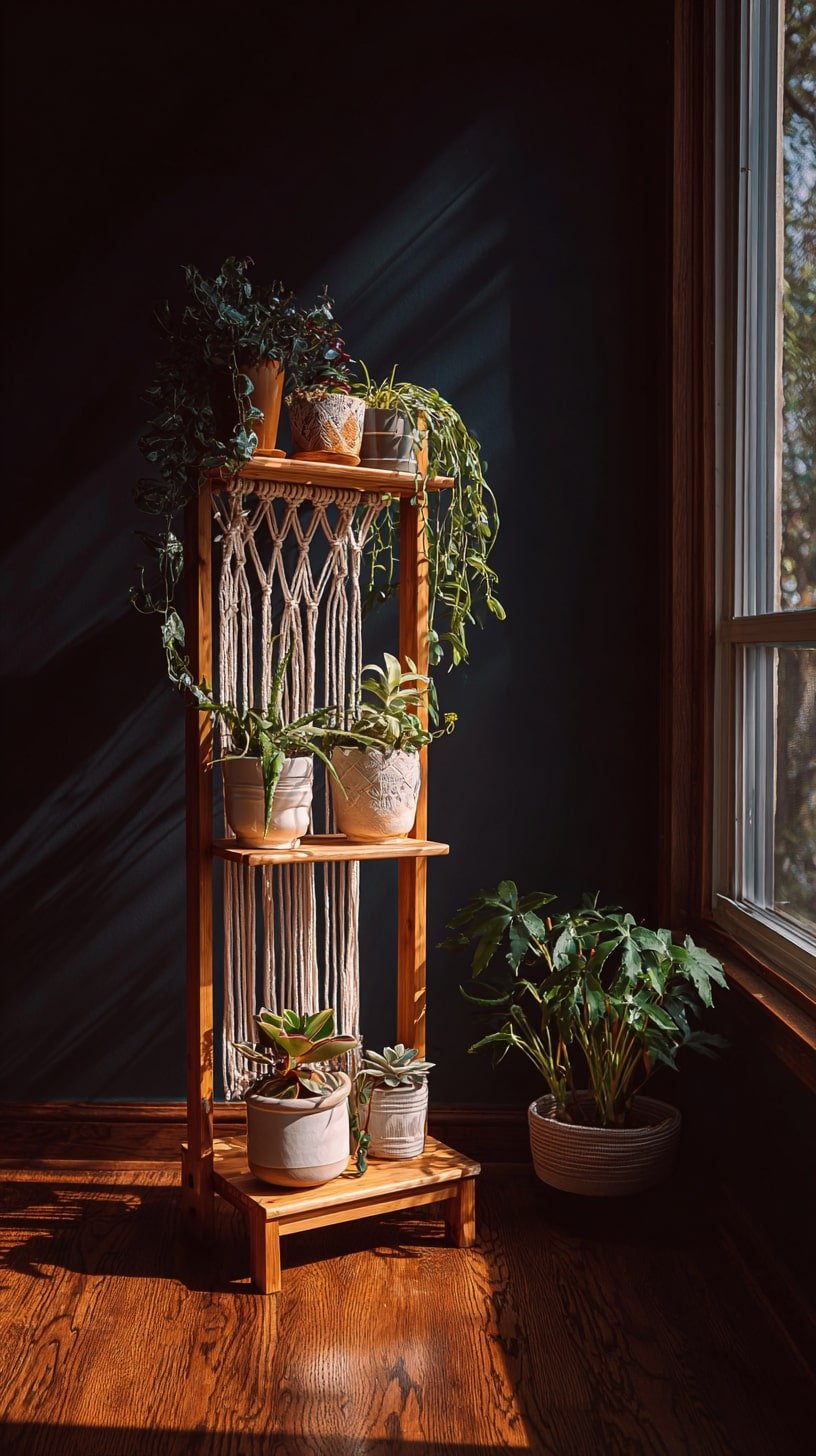
Mix texture and structure. A rigid wood frame grounds the look, but that knotted rope panel softens everything.
19. Lean a Weathered Ladder for Instant Vertical Charm
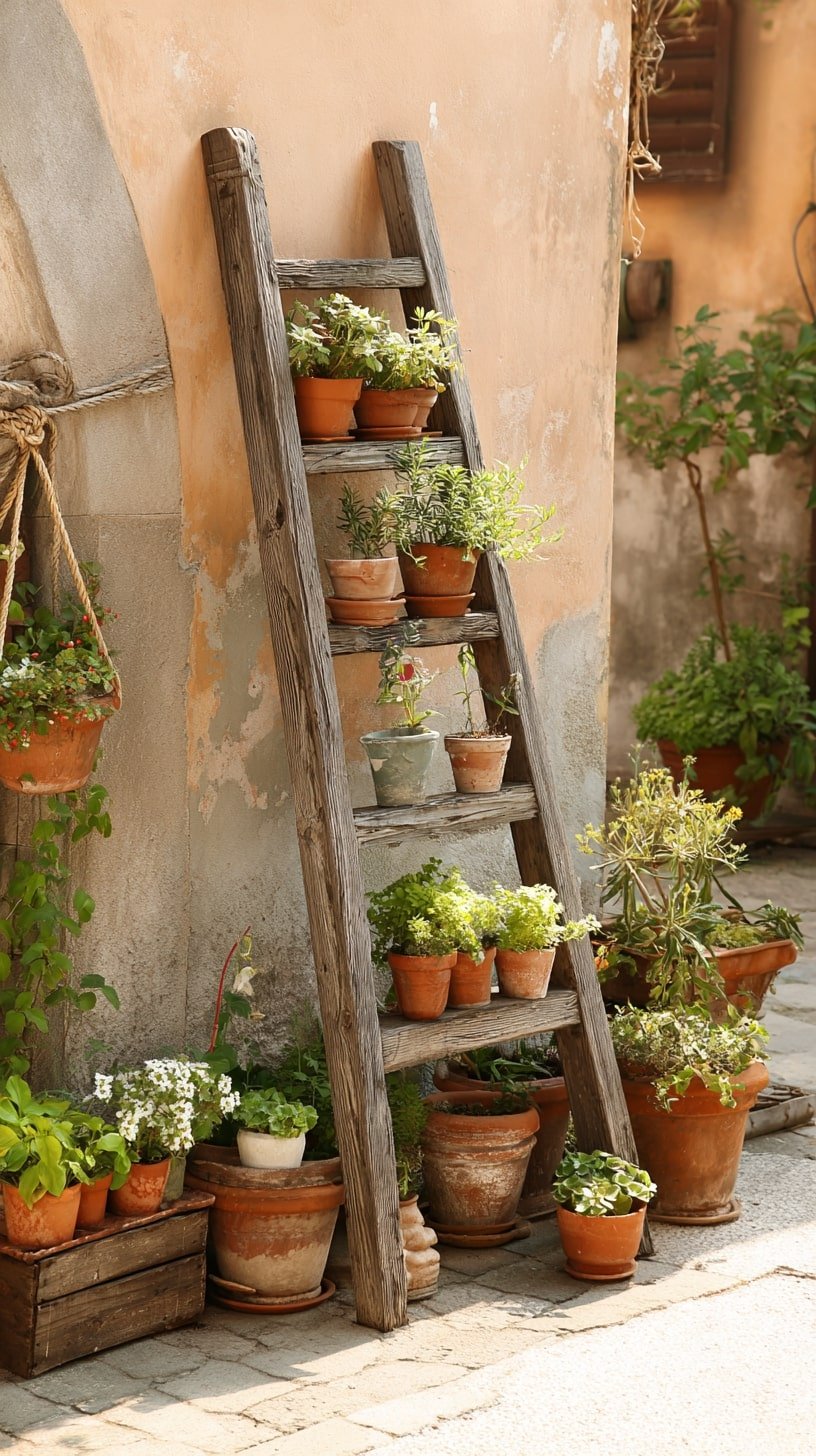
Work with what ages well. Here, a sun-bleached ladder leans casually, but every rung earns its place. Each terracotta pot feels collected, not curated. There’s no perfection, just pattern.
Spacing does most of the lifting. Air gaps between tiers give the plants light, breathing room. Easy rhythm. Balanced clutter. Great for small courtyards or alleys with warm walls that glow late afternoon.
20. Mount a Mini Ladder Shelf for Rustic Wall Storage
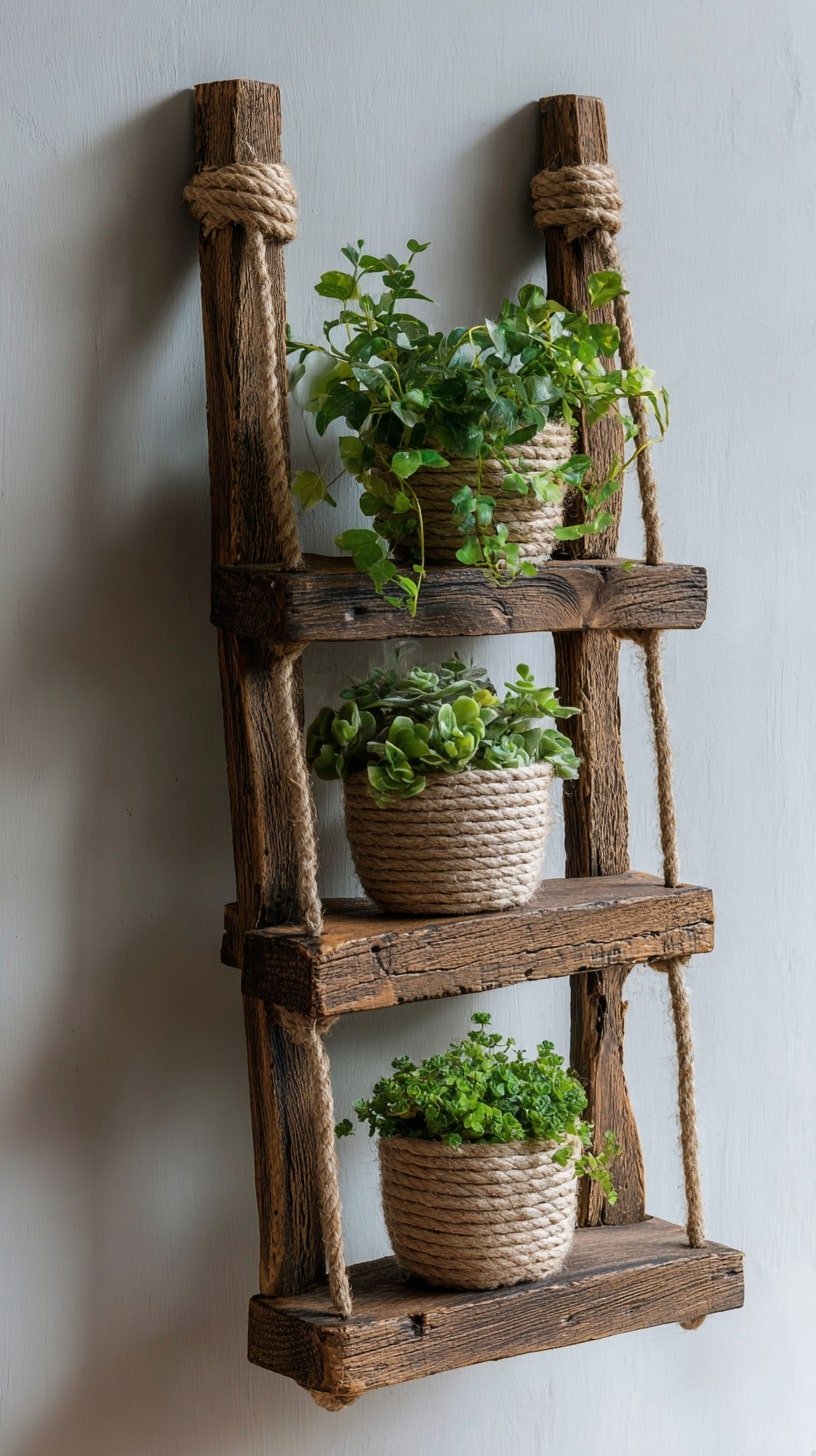
Simple. Compact. Smart. This wall-hung ladder shelf makes rope do double duty,structure and style. Tightly wound sisal softens the visual weight while amplifying texture.
Chunky reclaimed wood adds heft. Every joint looks hand-finished. Planters echo the rope with coiled exteriors, tying the whole look together.
Best in narrow spaces where depth matters. Great for herbs, vines, or trailing ivy.
